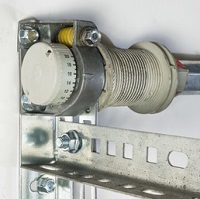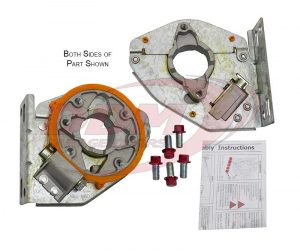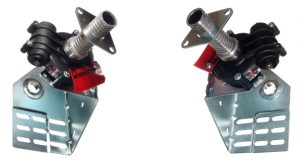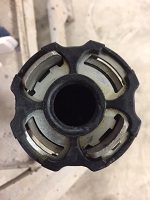Posted July 21st, 2017 at 1:52 pm by Sales Team
Winding residential torsion springs is dangerous. If you are not careful, and if you do not have the proper tools, it is easy to get hurt. To make the process safer for DIYers, a number of garage door manufacturers developed their own torsion spring winding systems. Below are the more common ones.
Wayne Dalton TorqueMaster Winders
There are two types of winding systems for Wayne Dalton torsion springs. There is the original TorqueMaster I system, as well as the newer TorqueMaster Plus, also called the TorqueMaster II, system. In each system, the spring or springs mount inside a metal shaft. In addition, the winding units mount at the very ends of the shaft to the vertical jamb and flag angle.
TorqueMaster I. The winding unit for the original system contains gears that are wound using a drill with a 7/16″ socket or nut driver. The teeth of the drive gear secure the winding cone. The spring winds as the winding bolt turns the worm gear, which turns the drive gear. A numbered wheel on the unit indicates the number of turns on the spring.

TorqueMaster II. The TorqueMaster Plus winder uses a ratcheting system and a 5/8″ socket to wind the springs. The gears turn the winding cone at each end, and the ratcheting mechanism holds the spring tension. There is no wheel to record the turns. Installers mark the shaft or socket to count the number of turns.

Here are some additional helpful links: Wayne Dalton Garage Door Parts, Wayne Dalton TorqueMaster Torsion Springs, TorqueMaster Torsion Spring Replacement, How to Unwind TorqueMaster Plus Springs, and How to Wind Torquemaster One Springs.
Clopay, Ideal & Holmes EZ-SET Winders
The EZ-SET winding system requires gapped torsion springs that mount on the outside of the shaft. Then, the winding units mount next to the cable drums on an end bracket that bolts and screws to the jamb and end plates. The winder cone slides into the winder, and the opposite end secures to the shaft with set screws. After the spring cones are secured, tension is applied by turning the winding screw with a drill.

Here are some additional helpful links: Left side winders, Right side winders, EZ-SET Parts, How to Replace EZ-SET Torsion Springs, How to Convert from EZ-SET Springs to Standard Torsion Springs.
Arrow Tru-Line – ATL – S3 Winders
The ATL winder mounts near the center of the shaft and functions as both a spring anchor bracket and spring winder for standard residential torsion springs. The stationary cones secure to the spring winder and the winding cones secure to the shaft with set screws. You must stretch the springs before tightening the set screws. After stretching the spring, and securing the set screws, use a drill to turn the tensioning screw and wind the spring or springs. Only standard residential torsion springs and standard lift drums are compatible with this winder.

You’ll find Instructions for Installing Arrow Tru-Line Winders on our ATL Winder page.
Spring King – Simple Set – Winders
Unfortunately, Spring King winders have been discontinued.
Similar to the other torsion spring winding systems, Spring King winders mount near the ends of the spring shaft. They bolt to special end bearing plates. The winder end of the spring secures to a steel plate mounted on the winding unit shaft. The cone at the other end secures to the shaft with set screws. The springs must be stretched before being wound. The distance of stretch is based on the spring’s wire size and the door height. Turning the winding screw rotates the winding unit plate and thus pulls the steel plate closer to the winder. Once the plate meets the winding unit, the spring starts to wind. These units work only with standard residential torsion springs and cable drums.

2023 Update: The Torsion Spring Safe-T-Winder™
The Torsion Spring Safe-T-Winder™ is a new type of winding system that mounts at the end of the shaft. It attaches directly to the torsion shaft. As a result, you only need one winder to wind all the springs on a single shaft. You must stretch the springs before winding. Once you have stretched the springs, use a drill to wind the springs the desired amount.

Instructions for using the Safe-T-Winder can be found on our post, “How to Install the Safe-T-Winder.”
Overhead Door – OHD – Armortite Winders
As with the other winders OHD, the left wind spring mounts to the left end of the shaft, and the right wind spring mounts to the right end. Unlike most of these systems, each spring mounts inside its own aluminum tube – thus the name “ARMOR-TITE.”

The tabs of the stationary cones secure into the cable drums, and the tabs of the winding cones secure into a retaining plate. The outer shape of this plate matches the indentations in the aluminum tube, which secures to the winding unit.

The winding unit mounts on the end plate and to the inside of the cable drum. To wind the spring, remove the retention pin from the winder. The winder must be turned clockwise using a hand drill with a 5/16″ Allen hex bit. Instructions for this equipment begin on page 28 of the Overhead Door Residential Installation Instruction Manual.
Dan’s Reviews
Standard torsion spring systems are the least expensive, and they provide the most options. However, they are also the most dangerous. This led to the development of winders.
When selecting a winding system to convert from extension springs or from standard torsion springs to a spring winding system, there are several factors to consider: quality, material cost, shipping cost, amount of work, adaptability to jackshaft operation, and the ability to upgrade the cycle life of the springs.
Recommendations
These are the torsion spring winding systems we would recommend using.
ATL Winder
We usually recommend the Arrow Tru-Line Winder. It is usually the least expensive, it usually requires the least amount of work, and it allows for installing any of the longer life torsion springs we provide. There are two disadvantages. One is that the springs have to be stretched before winding. This can be challenging when the wire size is larger than .250. In addition to this, with the ATL Winder, you can wind and unwind the springs a total of three times before you risk damaging the gears. Normally this will not be a problem. These winders are jackshaft operator compatible.
Safe-T-Winder™
For another way of winding torsion springs, see our 2022 blog post on the new Safe-T-Winder™. The Safe-T-Winder™ is at least as easy to use as the ATL Winder, and is compatible with any of the longer life torsion springs we provide. There is also no limit to the number of times you can wind and unwind the springs. The Safe-T-Winder™ is rated for doors up to 1,500 pounds, and can be used on residential, commercial and industrial doors. The main disadvantage is the cost, as the Safe-T-Winder™ is far more expensive than the ATL Winder. Nevertheless, if you are frequently required to wind and unwind garage door springs, it is likely that you will quickly recoup the cost through better safety and efficiency.
Spring King/Simple Set Winders
Before they were discontinued, Spring King / Simple Set Winders had been the only other winders we would recommend. This system allows for installing any of the longer life torsion springs we provide, and, for a single spring system, the cost is actually a little less than the cost of the ATL Winder. On a two spring system, however, the cost is almost twice as much. Installing these may also be a little more work. The two advantages over the ATL Winders is that the Spring King Winding System stretches the springs for you, and there is no limit to the number of times you can wind and unwind your springs. These winders are also jackshaft operator compatible.
Other Systems
We do not recommend converting to the Wayne Dalton TorqueMaster System because of the material and shipping costs. These start at $250 to $300 for a single-car door and, because of special crating and over the road shipping, prices start from $600 for a double car door. Cycle life options are also limited, and these are not readily adaptable to jackshaft operation.
Nor do we recommend converting to the Clopay EZ-SET System. This is because they make these winders from plastic and we’ve seen a lot of problems with those over the years. The specially gapped springs with special spacers also cost about twice as much as the standard springs. In addition, there is a limit to longer life options and you cannot install jackshaft openers on them.
We don’t recommend the Overhead Door Armortite System because of the cost, and because of the difficulty of installation. These systems are jackshaft operator compatible.
This entry was filed under Customer Input, How Garage Doors Work, Technical Support. You can follow any responses to this entry through the RSS 2.0 feed. You can skip to the end and leave a response. Pinging is currently not allowed.


Leave a Reply